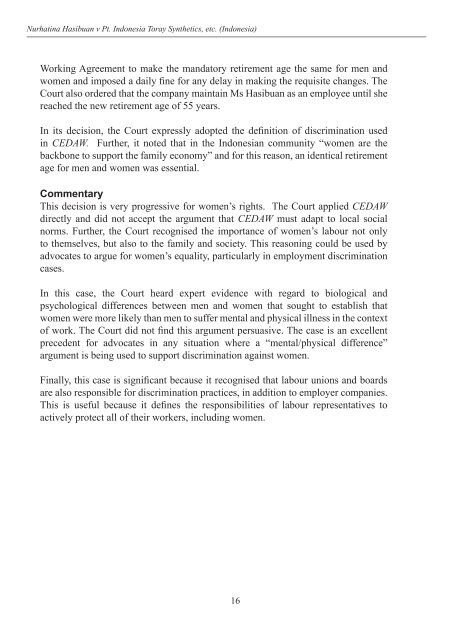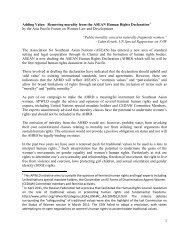A Digest of Case Law on the Human Rights of Women - Asia Pacific ...
A Digest of Case Law on the Human Rights of Women - Asia Pacific ...
A Digest of Case Law on the Human Rights of Women - Asia Pacific ...
You also want an ePaper? Increase the reach of your titles
YUMPU automatically turns print PDFs into web optimized ePapers that Google loves.
Nurhatina Hasibuan v Pt. Ind<strong>on</strong>esia Toray Syn<strong>the</strong>tics, etc. (Ind<strong>on</strong>esia)<br />
Working Agreement to make <strong>the</strong> mandatory retirement age <strong>the</strong> same for men and<br />
women and imposed a daily fine for any delay in making <strong>the</strong> requisite changes. The<br />
Court also ordered that <strong>the</strong> company maintain Ms Hasibuan as an employee until she<br />
reached <strong>the</strong> new retirement age <str<strong>on</strong>g>of</str<strong>on</strong>g> 55 years.<br />
In its decisi<strong>on</strong>, <strong>the</strong> Court expressly adopted <strong>the</strong> definiti<strong>on</strong> <str<strong>on</strong>g>of</str<strong>on</strong>g> discriminati<strong>on</strong> used<br />
in CEDAW. Fur<strong>the</strong>r, it noted that in <strong>the</strong> Ind<strong>on</strong>esian community “women are <strong>the</strong><br />
backb<strong>on</strong>e to support <strong>the</strong> family ec<strong>on</strong>omy” and for this reas<strong>on</strong>, an identical retirement<br />
age for men and women was essential.<br />
Commentary<br />
This decisi<strong>on</strong> is very progressive for women’s rights. The Court applied CEDAW<br />
directly and did not accept <strong>the</strong> argument that CEDAW must adapt to local social<br />
norms. Fur<strong>the</strong>r, <strong>the</strong> Court recognised <strong>the</strong> importance <str<strong>on</strong>g>of</str<strong>on</strong>g> women’s labour not <strong>on</strong>ly<br />
to <strong>the</strong>mselves, but also to <strong>the</strong> family and society. This reas<strong>on</strong>ing could be used by<br />
advocates to argue for women’s equality, particularly in employment discriminati<strong>on</strong><br />
cases.<br />
In this case, <strong>the</strong> Court heard expert evidence with regard to biological and<br />
psychological differences between men and women that sought to establish that<br />
women were more likely than men to suffer mental and physical illness in <strong>the</strong> c<strong>on</strong>text<br />
<str<strong>on</strong>g>of</str<strong>on</strong>g> work. The Court did not find this argument persuasive. The case is an excellent<br />
precedent for advocates in any situati<strong>on</strong> where a “mental/physical difference”<br />
argument is being used to support discriminati<strong>on</strong> against women.<br />
Finally, this case is significant because it recognised that labour uni<strong>on</strong>s and boards<br />
are also resp<strong>on</strong>sible for discriminati<strong>on</strong> practices, in additi<strong>on</strong> to employer companies.<br />
This is useful because it defines <strong>the</strong> resp<strong>on</strong>sibilities <str<strong>on</strong>g>of</str<strong>on</strong>g> labour representatives to<br />
actively protect all <str<strong>on</strong>g>of</str<strong>on</strong>g> <strong>the</strong>ir workers, including women.<br />
16



